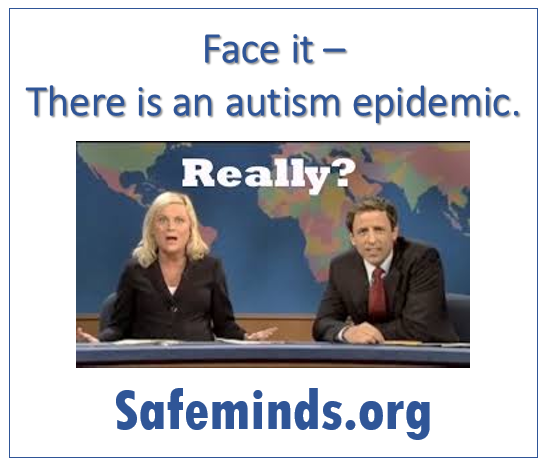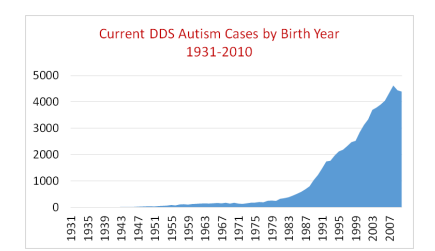Face it, There IS an Autism Epidemic
No matter how many times you repeat a lie, you cannot make it true.
No matter how much you want something in front of your face not to be real, you cannot make it disappear.
You may have heard in the news lately that “autism is not really on the rise” or that “there is no autism epidemic.”
SafeMinds supporters know, I know, the CDC knows, and anyone who is paying any attention at all knows that there are more children with autism in America than ever before, and the numbers keep going up.
There has been an explosion of autism.
There has been an explosion of severe autism.
The kind of autism that comes with substantial disability. The kind the State of California defines as having “significant functional limitations” in self-care; receptive and expressive language; learning; mobility; self-direction; capacity for independent living; or economic self-sufficiency.
The kind the best prevalence tracking system for severe autism – the California Department of Developmental Services – says has increased 21% among children born in just the 5 years from 2002 to 2006.
I’m talking about children who, for example, will never be able to take care of themselves, who need one-on-one classroom aides, who cannot speak for themselves, who are 12 years old and still wear diapers. I’m talking about the child with autism in so much pain that he beats himself bloody, whose parents had to institutionalize him.
I’m talking about the children and adults with autism who also have co-occurring conditions: gastro-intestinal problems, sleep issues, seizure disorders, metabolic disorders, motor problems.
I’m talking about the children who can’t communicate what is going on inside their bodies and minds without significant facilitation, if at all.
I’m talking about the ones who wander or elope from home and are at high risk of death.
These are children and young adults who will need lifelong specialized care.
I grew up in the 1980s. I attended public high school right outside New York City. Guess what? We had special needs kids in my graduating class of some 500 students. But we had very few, if any, students with autism. I didn’t even know any regular students with a brother or sister with autism. Autism simply wasn’t there. Not like it is today.
Today, almost every teen or young adult knows someone with autism – in their school, a friend’s sibling, or their own brother or sister.
Anytime I share with someone my age that my son has autism, they tell me about their niece or nephew, their own child, their grandson, their cousin’s daughter. Our parents were not having these conversations. Not because of changed diagnostic criteria. But because those kids simply were not there.
Look on the playground. Look at the supermarket. Go to the shopping mall.
Where there were once almost no children with autism, there are now thousands.
Anyone who has ever participated in multi-age, special needs athletics programs knows what I’m talking about. Very few of the adult athletes have autism. Hundreds of the younger participants, however, do.
Every school administrator and classroom teacher in America knows the truth.
Ask Dannae Laqua, a special education teacher in Oregon.
“I’ve been teaching special education for ten years,” Laqua tells me. “I’ve noticed a dramatic increase in students in school affected by autism. Ask any teacher and they’ll say the same thing.”
The waiting list for Autism Waiver services in Maryland is so long that your child might age out before getting the help he needs.
There are many theories postulated by people with advanced degrees about what the causes of autism could be: acetaminophen, overexposure to ultrasound,overuse of antibiotics, toxic ingredients in vaccines, air pollution, among many others.
Each of these theories must be thoroughly researched and investigated.
Yet instead of doing the needed research, we’re still arguing about numbers? I think it would be appropriately ridiculous for Seth Meyers and Amy Poehler to do a Saturday Night Live sketch of REALLY??? With Seth and Amy about this topic already.
Enough is enough—the emperor has no clothes.
It’s a convenient argument: if there is no autism epidemic, there’s no reason to be worried, there’s no reason to fund research into environmental factors, and then there is no reason to research treatment for people and stopping the epidemic. The majority of research funds today continues to be spent on genetic factors, and guess what, we still don’t have definitive answers on what causes autism.

Study or no study, you can’t help but see it with your own eyes.
Long waiting lists for outpatient behavioral services.
Long waiting lists to see a good developmental pediatrician.
Long waiting lists for respite services.
Long waiting lists for adult day programs
Skyrocketing special education costs.
They can tell us there’s no autism epidemic but we all live it. Every day.
Denying the autism epidemic holds all of us back from finding solutions. It keeps us from educating parents and doctors about how best to protect this country’s children.
SafeMinds knows the autism epidemic is serious, just like you, our supporters do.
And we aren’t arguing about semantics or trying to distract people from the real problem. We are, instead, focusing on funding research to figure out what is causing it, how to help children who have it, and what to do to stop it. We want healthier children with more independent futures. If you’d like to help us achieve our mission of ending the autism epidemic, please contact us here .
To those claiming that there is no epidemic and it’s just better diagnosis, please stop insulting our intelligence and wasting our time. Really.
There’s an autism epidemic. You know it. I know it.
We can and will do much better once we all face what is right in front of our own eyes, and then move forward in helping those who need it most.


